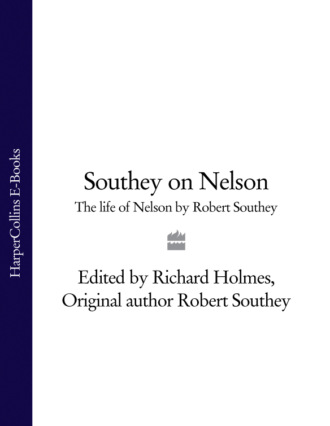
Полная версия
Southey on Nelson: The Life of Nelson by Robert Southey

Southey on Nelson
The Life of Nelson by Robert Southey
EDITED WITH AN INTRODUCTION BY
Richard Holmes

Table of Contents
Cover Page
Title Page
INTRODUCTION
SELECT CHRONOLOGY
AUTHOR’S PREFACE
THE LIFE OF NELSON
ONE
TWO
THREE
FOUR
FIVE
SIX
SEVEN
EIGHT
NINE
FURTHER READING
INDEX
Classic Biographies Edited by Richard Holmes
Copyright
About the Publisher
INTRODUCTION
1
Once he became a fleet-commander, Nelson always liked to lead his ships into battle flying naval signal number sixteen from his topgallant mast-head. Signal number sixteen consisted of two flags, one above the other: the uppermost white with a blue cross, the one below a patriotic red, white and blue. Even at the battle of Trafalgar, after he had issued the immortal message ‘England expects that every man will do his duty’, Nelson hoisted signal number sixteen as his last general command to his battle fleet.
Its meaning was a dare as much as an order, and it was particularly relished by his officers, his ‘band of brothers’, who considered it typical of Nelson’s attitude to life in general. Signal number sixteen, applicable in all conceivable circumstances, meant: ‘Engage the enemy more closely’.
It was flying at 1pm on 21 October, 1805, when Nelson was hit by a musket ball on the quarter deck of the Victory; and it was still flying when he died three hours later, in the surgeon’s cockpit, asking Captain Hardy to kiss him farewell, and to tell him how many enemy ships had surrendered.
2
Even before his heroic death at Trafalgar aged forty-seven, Nelson had become a national legend in a way that was virtually without precedent. His personal bravery, his astonishing aggression in battle, his loyalty to his fellow officers and his kindness towards his able seamen (especially his young midshipmen), were famous throughout the Royal Navy. But his gallantry, his self-sacrifice, and his fervent patriotism had made him a celebrity, in a quite modern sense, throughout the whole of England. Nelson was a new breed of war hero, a profoundly Romantic figure, who had caught the popular imagination and become the embodiment of a new kind of English nationalism.
There were, of course, historical reasons for this. The patriotic war against revolutionary France, which began in earnest in 1793, brought growing fears of invasion and subversion. By 1800, the military successes of Bonaparte had personalised this threat, and even brought fears of defeat and dictatorship. This slowly transformed the mood of radical discontent, and popular disaffection, that had gripped England (and especially its writers and intellectuals) for over a decade. Nelson became the personal focus of a deep, stirring movement of national unity and recovered common purpose. It was no coincidence that he led the most glamorous and successful of the British armed services of the period, and that there were very few families of the landed and middle classes–the families of Jane Austen’s novels–who did not have a father, brother, son, grandson, or uncle in the navy.
The Royal Navy was also a powerful and modern force. An English warship or ‘ship of the line’, carrying upward of seventy-four, eighty-six, or a hundred guns and a crew and armed personnel of 500 was the most sophisticated, complex and expensive military machine of its time. The English fleets were small compared to those of France or Spain, but they were better equipped and disciplined, with fierce loyalties among the crews, and strong family affections (and rivalries) between the officers. English navigation and gunnery could not be matched, and when Nelson boasted that ‘one Englishman was worth three Frenchmen’, he meant that his crews could sail across the Atlantic twice as fast, and his gunners fire three broadsides to their one.
English fleets might appear virtually anywhere in the world–off the coasts of America, India, Egypt, the Baltic states, or throughout the Mediterranean–and until the successes of Wellington’s armies after 1811, they represented the one check to Bonaparte’s global ambitions. In this sense the Royal Navy, and its figurehead in Nelson, represented not only England, but a certain kind of European freedom.
3
But Nelson had become a legend, above all, because of his charismatic personality. For the English public, his whole life was seen as one unbroken act of heroism, starting as a fifteen-year-old midshipman fighting a polar bear on an artic ice flow, and continuing without check until Trafalgar some thirty years later. Yet in fact neither recognition nor success came quickly to Nelson.
After mixed service in the West Indies, South America, the Baltic, Canada and the Caribbean, Nelson was a seasoned officer and a post-captain at the age of thirty. But he had never yet commanded a ship larger than a small frigate, the twenty-eight-gun Boreas; he suffered from sea-sickness, recurrent malaria, and severe bouts of depression; and he frequently considered resigning from the Service. For five years between 1788 and 1792, he was simply an unemployed navy officer, quietly married but without children, and living on half-pay at his father’s rectory, in the remote Norfolk village of Burnham Thorpe. On Saturdays he would ride three miles to the little tidal harbour of Overy Staithe, to sit on the sea wall, read the Navy Chronicle and watch the fishing boats.
It was not until the outbreak of war with revolutionary France, that he was given command of the sixty-four gun frigate the Agamemnon, in January, 1793. He served quite successfully in the Mediterranean, notably on the Corsica station in 1794, but he lost the sight of his right eye at the siege of Calvi, and his general health continued bad. It was only three years later that Nelson first really made his distinctive mark at the battle of Cape St Vincent in February, 1797, when he disobeyed his commander Sir John Jervis (later Lord Vincent) by breaking the battle line–‘without a moment’s hesitation’—to sail directly and alone into the huge Spanish fleet. He was promoted Rear Admiral, and appointed a Knight of the Bath. However later that year, while leading a bloody sea-borne landing at Santa Cruz in July, he lost his right arm.
The following year, 1798, he was at last given his first major command aboard his flagship the seventy-four gun Vanguard. He pursued the French fleet relentlessly back and forth across the Mediterranean. He finally trapped it outside Alexandria, anchored in Aboukir Bay. In a dazzling display of seamanship he annihilated what had been Napoleon’s Egyptian invasion fleet, at the Battle of the Nile in August 1798. This was the first great strategic British victory against revolutionary France. Gillray cartooned Nelson sweeping the enemy from the seas with a crocodile for a cudgel, and from now on his reputation spread like wild-fire among the general public.
His exploits were for the first time widely reported in the daily papers, including the newly founded The Times, which ran gossip items about him as well as battle reports. Nelson found that, unlike most other naval commanders who cultivated bluffness and understatement (like his great friend the taciturn Cuthbert Collingwood), he had a natural gift for extravagant publicity. He was a master of the peremptory official dispatch to his superiors, and the vivid post-action narrative rapidly and skilfully composed, for the benefit of the Admiralty. His account of ‘Nelson’s Patent Bridge’ for boarding enemy ships at Cape St Vincent, was celebrated in the fleet for its cheek, and quickly appeared in The Times. His description (not unbiased) of his tactics at Aboukir Bay, and the explosion of the huge French flagship L’Orient at night, was so famous that Turner painted a picture of it.
Nelson understood the essentially dramatic nature of naval command, and the natural theatre of the quarterdeck. Here a captain not only commanded an entire ship’s company for months on end, but also performed for its benefit. Time and again, in the heat and roar of action (when few men could even think clearly), Nelson not only demonstrated his extraordinary coolness, but proved he had a genius for producing the symbolic gesture and the memorable phrase: ‘A laurel or a cypress for my head’; ‘Westminster Abbey or victory’. His words and gestures before and during his last two great battles, Copenhagen (April 1801) and Trafalgar (October, 1805), became so widely known, almost proverbial, that later historians have sometimes treated them as folklore.
Yet Nelson was something of an historian himself. He kept very full diaries, and wrote brilliant descriptive and often highly emotional letters about his battles. These were not only sent to his friends and family, but also to his fellow officers and superiors, and were frequently leaked to newspapers. In fact diary-keeping and letter-writing (often later extended to memoirs) became characteristic of British naval officers of this period, just as a century later they would become characteristic of military officers on the Western Front. English naval writing during the Napoleonic War forms a literature of its own, and has subsequently inspired an entire maritime sub-genre of the modern historical novel, from C.S. Forester’s Hornblower series to Patrick O’Brian’s Jack Aubrey saga.
For Nelson, writing and deliberate phrase-making became an important expression of his turbulent personality and, increasingly, his sense of mission. It was he, and not a fellow officer, who invented ‘the Nelson touch’ in 1805, with its deliberate echo of Shakespeare’s ‘little touch of Harry in the night’ from Henry V; and it was he who adopted Shakespeare’s phrase, ‘we band of brothers’. It is significant that he kept his diary in duplicate so that it should not be lost and that in the last ninety minutes before action was joined at Trafalgar he wrote out his final diary entries, his testament, and his long battle prayer, in his own clear racing longhand, twice in full without a single alteration.
4
From the time of his return to England in 1800, now aged forty-two and the hero of the Nile, Nelson found he had become a universal celebrity, cheered by crowds, dined by City corporations, and painted by leading artists. His small, tanned, hawklike figure; his glazed right eye and his one arm, and above all the mass of decorations he always wore on his dark blue naval greatcoat (he was wearing four stars at the battle of Trafalgar), made him instantly recognisable. He was mobbed wherever he went, whether boarding a cutter in Portsmouth harbour, dining with the mayor of Norwich, or simply shopping in Piccadilly.
After his death at Trafalgar a full-blown Nelson cult developed. It produced pictures, poems, songs, medals, statues, marble busts, waxworks, china mugs, and commemorative dinners. Pubs, streets and babies, were named after him; and Haydn composed a Mass in his honour. His fellow officers introduced the after-dinner toast, ‘To the Immortal Memory’, which is drunk in Royal Navy ward-rooms around the world to this day. In 1842 Nelson’s Column with its seventeen-foot high statue on top, was erected in Trafalgar Square.
This startling phenomenon has sometimes been compared to the aftermath of the death of Diana, Princess of Wales, in 1999. But it was far more deeply-rooted, in a sense of national pride, renewed identity and wartime achievement. Trafalgar was always understood as a defensive victory, not a conquest. It was the saving of Britain from foreign invasion, and hence an assertion of freedom, not of empire. It has perhaps more revealing analogies with the Battle of Britain of 1940.
The memory of Nelson compelled huge and lasting personal loyalty among all seamen, and tales of his exploits became legendary. For many men, contact with Nelson became in retrospect the defining moment of their lives. In a tiny Kentish churchyard, on the banks of the River Rother (which flows into the Thames estuary), I once stumbled upon a tombstone whose inscription read simply: “William Burke, Purser aboard his Majesty’s ship Victory, and in whose arms the immortal Nelson died.’
The witnesses of Nelson’s death are well-known to have been Dr Beatty, his surgeon, Dr Scott his chaplain, and Thomas Hardy, his ship’s captain. Yet the small, balding middle-aged William Burke did in fact support Nelson’s head during the three agonising hours it took him to die, kneeling down between him and the bulkhead, holding his shoulders in the dark, barely speaking a word. William Burke chose to record this moment in a perfect, but surely unconscious, iambic pentameter. The memory of Nelson had inspired the retired naval purser with a another fragment of English poetry, as a noble as an unwritten line from Shakespeare’s Henry V. ‘And in his arms the immortal Nelson died.’
5
Yet many of those contemporaries who knew Nelson best recognised profound contradictions in his character. When Wellington first met him, he thought Nelson ‘a charlatan’. Lord Minto described him as ‘a great man who was in some respects a baby’. His old commander in Chief Sir John Jervis, later Lord St Vincent, one of the greatest naval leaders of his day, gave it as his deliberate opinion, nine years after Nelson’s death, that: ‘Animal courage was the sole merit of Lord Nelson, his private character most disgraceful in every sense of the word.’
Many of his superior officers thought he was arrogant and absurdly flamboyant. His high-handed actions as a young officer in the West Indies led him to be pursued for years for £20,000’s worth of civil damages. Sir Hyde Parker, whose signal to withdraw he famously ignored at Copenhagen in 1801, always considered him dangerously impetuous in action and a grave diplomatic liability. Lord Keith was regularly infuriated by his refractory attitude to strategic commands in the Mediterranean.
He was frequently accused of vanity and self-importance. His separation from his wife, Frances Nisbet, in 1800 was thought shameful by many, including most of his relatives. His increasingly public liaison with the young and extravagant Lady Emma Hamilton, was considered scandalous, then vulgar, and finally humiliating. His stepson, Josiah Nisbet, came to hate him and frequently expressed the hope that with his one eye and one arm Nelson might one day conveniently fall over the side of his flag ship. His old friend and one time subordinate, Sir Thomas Troubridge, viewing things from the cool high chambers of the Admiralty, thought that popular fame (and Emma Hamilton) had gone to his head, and to other parts of his body too. Many, like Gillray and Cruikshank, thought that there was something irresistibly ludicrous about the small strutting figure, weighed down by his huge medals and his plump mistress.
Perhaps most damagingly, while on the Mediterranean station between June, 1799 and July, 1800, it was said that Nelson had become too personally involved with defending the corrupt Sicilian government at Naples, where Sir William Hamilton was Ambassador to the royal court. Here Nelson was thought to have been drawn (or perhaps seduced) into the gravest acts of political double-dealing and injustice. He was accused of disobeying orders to withdraw from Naples by Admiral Keith, of reneging on a truce signed by one of his own officers, Captain Foote, and conniving at the unjust court martial and execution of a Neapolitan patriot and naval officer Commodore Caracciolo. Worst of all, he was accused of allowing more than ninety civilian prisoners, including many women, who were officially under his protection in evacuation ships, to be returned to shore and executed in the cruellest manner by the Neapolitan authorities. Indeed some accused Nelson of war crimes in the Mediterranean.
In this glaring combination of light and shade, Nelson’s meteoric career and extraordinary seductive character offered all the moral contradictions of a peculiarly Romantic hero. But the triumph and tragedy of Trafalgar in October, 1805 meant that initially his whole reputation took on the aspect of a simple martyrdom. It was produced a period of unrestrained national mourning; a state funereal at St Paul’s attended by thirty-six admirals; and a great outpouring of Nelson tributes, reminiscences, and memorabilia.
Yet even in death Nelson provoked extreme reactions. Benjamin West, the President of the Royal Academy, painted a huge mythological tribute, with a mournful shadowy Neptune handing up the shrouded and distinctly Christ-like figure of Nelson (supported by an angel and surrounded by winged cherubs) into the arms of a resplendent and trident wielding Britannia. It was a deliberate and solemn apotheosis, perilously close to a religious Pieta.
In an altogether different spirit James Gillray executed a witty coloured cartoon, showing Nelson lying comfortably back upon the bosom of a buxom Britannia (Lady Hamilton of course, in an operatic flood of tears), while attended by a kneeling sea-captain (a grim George III) and a hysterical flag-waving midshipman (the Duke of Clarence). A sea-sprite circled overhead blowing Nelson’s own trumpet. It spouted a single word: not the expected ‘Victory’, but the self-vaunting ‘Immortality’.
6
In a newspaper article of 1811, discussing the new Romantic interest in celebrity and biography, Coleridge described these years of the English Regency as ‘emphatically, the Age of Personality’. So it was not surprising that a figure like Nelson, who seemed so much larger-than-life, was bound to exercise a fascination on people by the very vividness of his character as much as by the heroism of his actions. He had been asked to write his own autobiography as early as October, 1799, and did indeed dash off a Sketch of his life for John M’Arthur, a naval journalist working as joint-editor of The Naval Chronicle.
The result was a curious mixture of modesty and melodrama. Nelson mentions in passing the loss of eye and arm, his childless marriage, his failure to achieve spectacular prize-money (from captured ships), and his strictly local success in ‘placing the King of Naples back on his throne’. But his conclusion is like one of his battle signals hoist to the topgallant mast-head. ‘Without having any inheritance, or having been fortunate in prize money, I have received all the honours of my profession, been created a peer of Great Britain, and I may say to the reader: GO THOU AND DO LIKEWISE.’
After his death, a mass of brief memoirs were hastily published, especially dealing with disputed events at the battles of Aboukir Bay and Copenhagen, and the controversy over Nelson’s actions–and inactions–at Naples. Encouraged by Lady Hamilton, an inaccurate and highly partisan study was published by James Harrison in 1806. The following year 1807 William Beatty published his Authentic Narrative of the Death of Lord Nelson.
Then the journalist John M’Arthur joined forces with a navy chaplain and historian James Clarke, to produce a massive semiofficial assemblage of papers, The Life and Services of Horatio Viscount Nelson from his Lordships own Mss published in two enormous volumes in 1809. It drew widely on Nelson’s letters and despatches, and commissioned or republished eyewitness accounts. These volumes had the support of Lady Nelson, and were notable for the fact that they did not mention Lady Hamilton at all. They also carried, as their frontispiece to set the tone, an engraving of Benjamin West’s heroic painting.
In the following year 1810, the newly founded Quarterly Review asked one of its fiercest reviewers to make a general assessment of the state of Nelson biography. It was five years after Trafalgar, the Napoleonic war was still at its height, and a patriotic encomium might have been expected. But the reviewer chosen was unusual: the poet and one-time pro-Jacobin rebel, Robert Southey. He was given the Harrison volume, the Clarke and M’Arthur, the Beatty memoir, and several lesser studies. In a forty-two page essay published in Quarterly Review No. 5, February, 1810, Southey was highly critical of all the volumes except Beatty’s precise and moving eye-witness account. He observed that Harrison was totally unreliable, and that Clarke and M’Arthur were almost literally unreadable, as their volumes ran to thousands of pages, were five inches thick, and weighed in at almost twenty-seven pounds. The Life lacked all narrative skill and selection, did not give a convincing picture of Nelson’s character, and did not address the question of Lady Hamilton, about whom Southey appended a long and waspish footnote.
Southey concluded by making an elegant précis of Nelson’s career, and observing that none of the writers before him understood the art of biography. True biography required above all three things: ‘industry, judgement, and genius: the patience to investigate, the determination to select, the power to infer and enliven.’
Southey’s shrewd publisher John Murray (already Byron’s publisher) immediately challenged Southey to write such a biography himself. Could not Southey easily turn the 10,000-word review into short and popular portrait of Nelson, to suit the taste of wartime readers, and to inspire young sailors? If he pitched it right, Murray could print ‘a large impression’ and also count on it ‘going off as a midshipman’s manual’. He had paid a hundred guineas for the review, and he now offered a further hundred guineas for the biography, which he reckoned Southey could complete within six months.
Southey enthusiastically accepted; but almost the moment he began serious research, was assailed by doubts. What could a literary man, living in deep rural retirement with his family in the Lake District, know of naval warfare, sailing terminology, the drama of the high seas and the intricacies of maritime diplomacy? Moreover, what could a poet understand of a warrior’s temperament like Nelson’s? He wrote to his brother Tom Southey, who was the sailor in his family: ‘I am such a sad lubber that I feel half ashamed of myself for being persuaded even to review the Life of Nelson, much more to write one…I walk among sea terms as a cat does in a china pantry, in bodily fear of doing myself mischief, and betraying myself.’ It was a properly domestic and unseamanlike analogy, and one that Southey would often repeat in self-deprecation.
In fact Southey was rather better qualified than he pretended. As a young man he had indeed made his name as a Jacobin writer, and a poet of long, lurid verse romances, like Thalaba, the Destroyer (1801), and The Curse of Kehema (1810). Their length and their absurd titles suggest why Lord Byron–among others – made fun of them. The verse was execrable, and yet the story-telling was strangely compelling. Southey realised that this suggested that his prose–which his private letters already show as crisp, vivid, and wonderfully engaging–might be a stronger suit than his poetry.
So now, a family man in his mid-thirties, he had deliberately set out to re-establish himself as an historian, and had done so with great success. Murray had just published the first volume of his massive History of Brazil, which was very well-received and Southey would dedicate a further nine years to completing it in three volumes (1810-1819). It was on the basis of this work, not his poetry, that he had originally been sent the Nelson books for review and why Murray now had such confidence in him.










